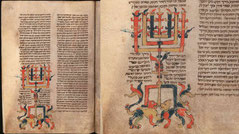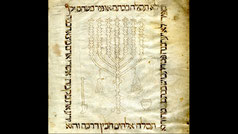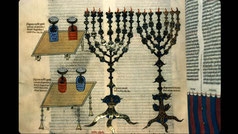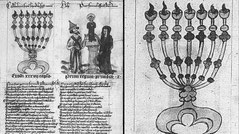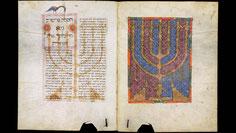ANCIENT AND NEW MENORAHS - 14th Century
This website shows historic menorahs from the fourteenth century. Menorah illustrations from other centuries: Ancient Menorahs until the 1st century, 2nd century, 3rd century, 4th century, 5th century, 6th-10th century, 11th-13th century, 15th century, 16th century, 17th century, 18th century, 19th century, 20th century, 21st century. Coins
Medieval Menorahs - 14th Century

1300. Enrico Nahum Bible. This manuscript Hebrew Bible with full vocalization, accentuation, and Masorah annotation was created in Spain. The Bible is illustrated and decorated in color, silver, and gold. The Masorah Magna notes are written in micrography. National Library of Israel. Source: Link1, Link2, Link3

1300 (12 tammuz 5060, June 30, 1300). The menorah, Pentateuch with vowels and signs of cantilation, accompanied by Onkelos' massore and targum, verse by verse, the five Megillot, the prophetic readings of Passover and Pentecost, Job. Poligny (Jura). Fol. 283v: A painted menorah, around which are represented the sacrifice of Isaac, the judgment of Solomon, and the lighting of the lamps of the candelabrum by Aaron. Bibliothèque nationale de France, Hébreu 36. Source: Link1, Link2, Link3

1301. Copenhagen Catalan Bible. Artist/ Maker: Menahem (Scribe). Origin: Catalonia, Spain. Menorah with its tongs snuffdishes and two stones. Below the Menorah is the jar of manna flanked by Aaron's flowering rod and Moses' barren rod. In the upper left compartment is the Ark of Covenant with the Tablets, topped by the two Cherubim. Location: Denmark, Copenhagen, Det Kongelige Bibliothek. Photograph Copyright: Center for Jewish Art. Source: Link1, Link2, Link3

14th century (1350–1374). Duke of Sussex's Catalan Bible. Full-page miniature of a menorah surrounded by Temple instruments, from a Hebrew Bible (the 'Duke of Sussex's Catalan Bible) with masorah magna and parva, Spain (Catalonia), 3rd quarter of the 14th century, Add MS 15250, f. 3v.

14th-15th century. Paris Bible. Hebrew Manuscript. Contains the Masoretic Lists (5v-7v), the haptaroth list (7v-12r), the Pentateuch (16v), Joshua, Judges, Samuel, Kings. The first pictures of the book contains furniture of the temple, the candelabrum, the tongs, the oil vase, two olive trees on a riotous mount and in the background, a sparkling gibbous moon. Origin: Catalonia, Spain. Location: Bibliothèque nationale de France, Hébreu 1314. Also: Center for Jewish Art. Source: Link1, Link2, Link3, Link4

14th century (1350-1400?). Foa Bible, Catalonia, Spain. Menorah with 22 almond blossoms and 66 flower items. Object Copyright: Compagnie des Prêtres de St. Sulpice. France, MS 1933. Photo Copyright: Center for Jewish Art. Source: Link
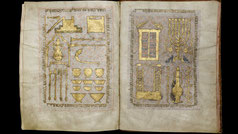
14th century (1st quarter). Hebrew Bible, Catalonia, Spain. Tempera, gold and ink on parchment Jay and Jeannie Schottenstein Collection, Columbus. Well after the destruction of the Temple, both the form of the monument itself and its fusion of law and art were perpetuated in 13th-14th century Catalan Hebrew Bibles. Surviving in more than 20 large-scale illuminated manuscripts, these works often include a double frontispiece brilliantly depicting an array of golden ritual vessels. Source: Link

1301-1400. Historia Scholastica by Petrus Comestor. Biblioteca Digital Hispanica, Spain (Shelfmark: Res/199). Source: Link

1301-1400. Historia Scholastica by Petrus Comestor. Scholastic History. Illustration of the Temple of Solomon. Gothic art. Miniature Painting. Madrid, National Library, Spain. A photograph by Everett, M.C.Esteban/Iberfoto/Everett Collection (391045). Fine Art America. Surce: Link

1301. Hebrew Bible. Tudela (Spain). Bible, with vowels and signs of cantillation. Big and small massore. Antiochus roll. Genesis (ff. 10v-39v); Exodus (ff. 39v-64v); Leviticus (ff. 64v-81v); Numbers (ff. 81v- 105r); Deuteronomy (ff. 105v-127r); Joshua (ff. 129r-144r); Judges (ff. 144r-159r); Samuel (ff. 159r-194r); Kings... Bibliothèque nationale de France. Département des Manuscrits. Hébreu 20. Source: Link1, Link2

1301-1400. 14th century Italian writing, on 2 columns. This manuscript contains, from folio 3 to 42 vo, 80 coloured drawings, two on each page. These drawings, which a note on the guard sheet attributes to Thaddée Gaddi, a Florentine painter and architect who died around 1366. Bibliothèque de l'Arsenal. Ms-593 réserve, Gallica. Source: Link1, Link2, Link3

1301-1500. Speculum humanae salvationis. Manuscript with initials in color. 183 paintings giving the illustration of the text. A strange shape of the seven-armed Menorah. Second image: Hannah presents Samuel to Eli in the temple. Language: Latin. Bibliothèque nationale de France, Département des manuscrits, Latin 511. Source: Link1, Link2, Link3

14th century. Bible Historiale. Title: "La Bible hystoriaus, où les estoires escolastres sont" Translator: Guiart des Moulins (Guyart des Moulins; 1251-1322); Pierre Comestor. Guyart des Moulins was a medieval monk. He is famous for being the author of the first Bible translation in French, the Bible Historiale. Language: French. Bibliothèque nationale de France, Département des manuscrits, Français 160, folio 128. Gallica. Source: Link
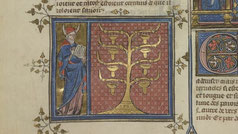
14th century. Bible Historiale. Title: "La Bible hystoriaus, ou Les hystores escolastres de Pierre..., traduction avec gloses de Guiart de Moulins." The menorah has a mistake because it has 8 arms. Language: French. Bibliothèque nationale de France, Département des manuscrits, Français 8, folio 132. Source: Link

Early 14th century. Hebrew Bible, Castile. Source: Link
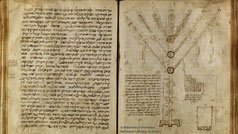
1305. Torah commentary on Rashi (1040-1105). The Palatina Library, Parma, Italy Cod. Parm. 3115. Language: Hebrew. © Biblioteca Palatina in Parma. This photo is only a screenshot from the website of the National Library of Israel. Please see the original website in better quality. Source: Link1, Link2

1307-1318. The secret of Domme, France. This small town held the jail that held 70 Templars captive. The Knight Templars were imprisoned from 1307 to 1318 during the trial against them. There are hundreds of Templar graffiti that still bear witness to this time. The Templars used their nails and teeth that had fallen out due to diseases, to make these engravings. The branches of the menorah do not curve upwards to an equal height as they should, a Cabbalistic interpretation? Link1, Link2, Link3
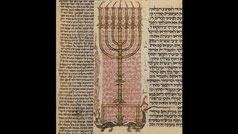
22. Oktober 1309 (17.[14.] Ḥeshwan 5070). Tora with Targum Onqelos, Haftarot (selections from the Prophets for use in a service), Megillot (the five scrolls Ruth, Song of Songs, Lamentations, Ecclesiastes, Esther) along with Targum, Job; commentary by Rabbi Shelomo Yiṣḥaq (‘Rashi’, Shlomo Yitzchaki; Latin: Salomon Isaacides; French: Salomon de Troyes; 1040-1105). Ashkenaz, Brussels. Parchment, 21x16,5cm. University Hamburg, Germany, Codex Levy 19. Source: Link1, Link2

1317. Bible Historiale. Title: "La Bible hystoriaus, ou les hystoires escolastres". Author: Guyart des Moulins (1251-1322) and Pierre le Mangeur. Language: French. Guyart des Moulins was a medieval monk. He is famous for being the author of the first Bible translation in French, the Bible Historiale. But this Menorah has 8 arms, not 7, as described in the Bible. Bibliothèque nationale de France, Code: Ms-5059 réserve. Gallica. Source: Link1, Link2

14th century. Hebrew Bible with masorah with masorah magna and parva, with masoretic lists at the beginning and at the end of the manuscript. Full-page miniature of a menorah. Image taken from f. 4 of Bible with ~masorah~. Written in Hebrew. Origin: France. Script: Franco-German square and semi-cursive script, partially punctuated. British Museum, London. Or 4227. Source: Link1, Link2, Link3

1320-1340. Guiard des Moulins, Bible Historiale Complétée (Vol. I). Exodus: Moses is ordered by God to make a golden seven-branched candlestick (menorah). Place of origin: Paris, Fauvel Master. ©Koninklijke Bibliotheek National Library of the Netherlands, Signature: The Hague, KB, 71 A 23. Source: Link

14th century (1st half). Speculum humanae salvationis. Avignon. Rome, Biblioteca Corsiniana → 55.K.2 (Rossi 17), fol. 21r. Source: Link

1320-1340. Speculum humanae salvationis. Location: Toledo, Archivo Capitular, MS 10.8, fol. 13r. Source: Link
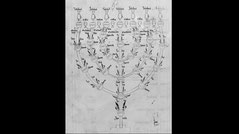
1322-1356. Representation of a seven-armed chandelier (menorah) with symbolic explanation. Place of origin: Kastl Kreis Amberg-Sulzbach, Germany. © Bildarchiv Foto Marburg. Source: Link

14th century (2nd quarter). Speculum humanae salvationis. Author: Albertus in Limburg, Bologna. Bayerische Staatsbibliothek, BSB-Hss Clm 146. Source: Link

1325. Bible historiale; written and illuminated in Paris, France. Moses: Instruction, Candelabrum, Ark, with golden top on which are two candelabra of gold, each with three candles, is flanked by five men, two wearing caps. The representation is not correct, because it shows two candlesticks instead of a seven-armed menorah. Diapered background. Author: Moulins, Guyart des Moulins (1251-1297). Language: French. Pierpont Morgan Library. MS M.323. Source: Link

1325-1350. Postillae in Testamentum Vetus by Nicholas of Lyra (ca. 1270-1349). Latin. Written by several scribe. 19 pen-and-ink drawings with washes in red, green, blue and pale yellow, some inserted into the text column, others up to half-page size dealing with the Tabernacle in the Desert and the Temple of Solomon: the drawings serve to clarify the written text by depicting differences in interpretations between Jewish and Catholic exegesis. Beinecke Library, Marston MS 215.: Link1, Link2

1325-1375. Catalan (Spain) Micrographic Mahzor. Sanctuary Implements: Shewbread table, Ark of the Covenant, Altar of Sacrifice, Menorah, Stepping Stone of the Menorah, Trumpets, Pots (sirot), Flesh-hooks (mazlegot), Basins (mizrakot), Shovels (ya'im), Snuffdishes (mahtot), Tongs (melkahayim), Jar of Manna, Aaron, Blossoming Rod, Micrographic carpet page. National Library of Israel. Photograph Copyright: Center for Jewish Art. Source: Link

1327. Seven-armed candlestick from Kolberg in Pomerania (German: Pommern). Artist: Hans Apengeter (*before 1300; †after 1351; Wikipedia, Deutsche Biographie). With the victory of the Reformation in Pomerania, the church became Protestant in 1531. After the WW2 the German population was expelled, the town was renamed to Polish Kołobrzeg and was settled by Poles from the previous eastern parts of the country. The church then became Catholic. Link1, Link2, Link3, Link4, Link5, Link6

14th century. The candlestick of the Marienkirche in Frankfurt an der Oder (Germany), (height 4.70 m) has two strong arms swinging out in waves from the uppermost knob of the shaft to both sides, from which smaller branches with candleholders branch off. The foot, supported by four eagles, is decorated with biblical scenes just like the trunk. Phot. State Photographic Office Berlin. Source: Link1, Link2, Link3, Link4

1330-1340. Medieval seven-armed chandelier menorah. The picture shows Samuel as a baby in the temple. Material, Technology: Colored pen and ink drawing. inventory number: at.imareal.007178. Austrian National Library, Vienna, Austria. Moreinformation: Institut für Realienkunde, Austria. Source: Link

1330. Bible historiale by Guiart des Moulins (translator). Chandelier à sept branches. Seven armed candlestick, but in but in reality this illustration has eight lamps, as the artist arranged the lamps symmetrically (error of the illuminator). Origen: France (Paris). Copyright: © Institut de recherche et d'histoire des textes - CNRS; Shelfmark: Paris - Bibl. Sainte-Geneviève - ms. 0022. Source: Link1, Link2, Link3, Link4

14th century (first quarter). Bible historiale. Author: Guyart Des Moulins (1251-1322); Petrus Comestor (prologue). A very strange form of the golden candlestick, four branches on each side. This does not correspond to the biblical guidelines. Material: Parchment. Page size: 380 x 290 mm. Place of origin: Paris. Shelfmark: MS. Douce 211, fols. 67r-76r. Source: Link

1331. Postilla in Bibliam. Two figures. Legend of the first figure: "figura candelabri secundum rabi salomone". Legend of the second: "figura candelabri secundum alios". Author: Nicolaus of Lyra. Language: Latin. Origin. France. Reference: Dole, BM, 024, Folio/page 189. Signature: Notice IRHT (M. Pengam), 2001. Source: Link1, Link2, Link3

1341. Title: Commentary on the Pentateuch with the Haftarot (ff. 1-240) on the Five Scrolls (Hamesh megillot; ff. 240v-270), and on the Haftarot for festivals (ff. 270-287v). Hebrew. Author: Solomon ben Isaak ('Rashi'). Origin: Germany. British Library, Egerton 872, f. 101v. Source: Link1, Link2, Link3

14th century. Pentateuch with Targum Onkelos and Rashi's commentary. Micrography of a menorah, at parashat wa-yaqhel (Ex. 35:1-38:20), next to the paragraph, ‘And he made the candlestick of pure gold’ (Ex. 37:17). Author: Solomon ben Isaac. Scribe: Samuel ben Hayyim. Origin: France. Source: Link1, Link2, Link3

1348. Igniting the Temple Menorah, from the Hammelburg Machsor (Hammelburger Machsor) from Bavaria (Kreis Bad Kissingen), Germany. Artist: Jakob ben Shneur (Scribe). © Universitäts- und Landesbibliothek Darmstadt (Inventar-Nr. Cod.or. 13). This image belongs to the ''Ursula and Kurt Schubert Archive'' in the Center for Jewish Art. Source: Link1, Link2, Link3

14th century. Title: "Speculum salvationis humanae metrice cum figuris pictis. Pugna virtutum et vitiorum cum figuris pictis". A special seven-armed menorah. Second image: Dedication of the young Samuel to the Lord, Hannah presents Samuel to Eli in the temple. Bayerische Staatsbibliothek (Germany), Signature: BSB-Hss Clm 3003. Source: Link

1350. The Speculum humanae salvationis (Mirror of Human Salvation) was a bestselling anonymous illustrated work of popular theology in the late Middle Ages. Material: Parchment. Origin: South-West-Germany. German title: "Heilsspiegel" or "Spiegel der menschlichen Erlösung." UB Augsburg – Oettingen, Wallersteinsche Bibliothek – Cod.I.2.2.23. Source: Link

1350-1400. Speculum humanae salvationis. Candelabrum: Central candle, flanked by six others, all with three flames, all surmounting arms decorated with leaves or fleurs-des-lis, emerging from base. Germany, probably Nuremberg (Nürnberg). Pierpont Morgan Library. MS M.140. Source: Link

1350. "Postilles sur la Bible" by Nicolas de Lyre, French School. From a commentary book by Nicholas of Lyra (1270–1349), author of the first printed commentary on the Bible and one of the foremost Franciscan theologians and influential exegetes (biblical interpreters) of the Middle Ages. Illuminated manuscript.Ms 290 Tome 1 f.89v. Table of offerings and the menorah. Bibliotheque Municipale, Cambrai, France. The Bridgeman Art Library Nr.: JLJ4670842. Source: Link1, Link2, Link3

Mid-14th century. Latin title: "Speculum humanae salvationis" (English: "Mirror of human salvation"; German: "Heilsspiegel" or "Spiegel der menschlichen Erlösung"). Handwriting on parchment. Language: German. Origin: East-Middle-Germany. Badische Landesbibliothek Karlsruhe. Signature: Karlsruhe 3378. Source: Link1, Link2

1360. Speculum Humanae Salvationis ("Mirror of human salvation"). This menorah has an almond blossom too much (23 instead of 22). The exact arrangement of the almond blossoms is very important, because it has a very specific significance, as is clear in the construction of the biblical menorah. Language: Latin and German. Origin: North-West-Germany. ULB Darmstadt. Signatur: Hs 2505. Source: Link
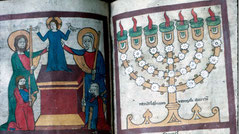
14th century (2nd half). Speculum humanae salvationis. The biblical Menorah has only 22 almond blossoms and not 25, as can be seen here. Closely related to LuHSB Darmstadt, Hs 2505 (previous owner: Klarissenkloster Clarenberg); either the two Hs have a common pattern, or the Darmstadt Hs was pattern for W* 105. Origin: Cologne (Köln)? Signature: Best. 7020 (Handschriften (W*) 105. Source: Link1, Link2, Link3, Link4

1360. Title: "Weltchronik." Universal chronicle in verse to the death of Charlemagne; written and illuminated in Regensburg, Bavaria, Germany. Picture: Moses: Tabernacle of Israel: Aaron, wearing pointed hat, stands next to Tabernacle as tent opened to show draped altar with two candlesticks, flanking jar; menorah is at right. Author: Heinrich von München. Pierpont Morgan Library. New York, MSM.769. Source: Link

1366-1382. The Farhi Bible was written by Elisha Crescas in Provence, France. It was in the possession of Haim Farhi up to his death in 1818. The page on the right shows the menorah, the thongs and fire pans. The page on the left depicts the table of showbread, the laver, the altar of burnt offering with its shovel and basin, flesh hooks and fire pans. Photo copyright: The Hebrew University of Jerusalem, The Center for Jewish Art. Source: Link1, Link2, Link3

14th century. "Postilla in Bibliam" (French: "Postilles sur la Bible") by Nicolaus de Lyra (Nicolas de Lire). Language: Latin. Toulouse, Bibl. mun., Ms. 0025, f. 084v. La Bibliothèque virtuelle des manuscrits médiévaux (BVMM). Source: Link

14th century. Postilla in Bibliam. Title: "Nicolai de Lyra, de ordine fratrum Minorum, Explanationes seu Postille super libros biblicos historiales (usque ad librum Judith inclusive". Manuscript. Language: Latin. Troyes BM / Ms. 400. La Bibliothèque virtuelle des manuscrits médiévaux (BVMM). Source: Link1, Link2, Link3, Link4

14th century. Manuscript Title: "Iohannes de Utino, Compilatio nova super tota biblia." This 6,5 meter long parchment scroll depicts the history of the world, from Adam and Eve up to Christ, as a “Heilsgeschichte” (history of salvation); central events are illustrated with multicolored pen and ink drawings. Representing later epochs up to the middle of the 14th century, tables list the popes up to Innocent IV (elected in 1352) as well as the kings and emperors up to Charles IV. Language: Latin. Source: Link

14th century. Scroll of parchment. Writing, with long lines and on 2 columns. Length: 8m, 75cm; width: 405mm. - Mounted on two sticks and enclosed in a cardboard case. Contains: "Origo Christi per hystorias Biblie"; Chronological history of popes and emperors from the birth of Christ to Benedict XII (1334-1342). Gallica. Bibliothèque de l'Arsenal. Ms-1234. Source: Link

14th century. Postilla in Bibliam by Nicolaus de Lyra. The golden lampstand (seven-armed-menorah), French: "Candélabre d'or." Origin: France (Paris ?). Copyright notice: © Institut de recherche et d'histoire des textes - CNRS, Shelfmark: Paris - Bibl. Mazarine - ms. 0157. Source: Link1, Link2, Link3

14th century. Title: "Postilla litteralis in Biblia". Nicolaus de Lyra. Bibliothèque nationale de France, Département des manuscrits, Latin 358. Gallica. Source: Link

14th century. Title: "Postilla litteralis in Biblia". Nicolaus de Lyra. Bibliothèque nationale de France, Département des manuscrits, Latin 360. Gallica: Source: Link

1370-1400? Modena First Catalan Bible. In the centre of the panel is the Menorah with its tongs, snuffdishes and two stones. At the bottom, flanking the base of the Menorah, are the jar of manna and Aaron's rod on the right, and Moses' rod on the left. Origin: Spain, Catalonia. Location: Italy, Modena, Estense University Library (Alpha.M.8.4 - Or. 90). Photograph Copyright: Center for Jewish Art. Link1, Link2

1370-1400? Modena Second Catalan Bible. Origin: Catalonia, Spain. Sanctuary Implements: Menorah, Stepping Stone of the Menorah, Snuffdishes (mahtot), Tongs (melkahayim), Spoons of frankincense (kapot for levonah zakah), Shewbread table, Ark of the Covenant, Jar of Manna, Aaron, Blossoming Rod, Moses, Rod of Carpet page. Location: Estense University Library, Italy. This image belongs to the ''Ursula and Kurt Schubert Archive'' in the Center for Jewish Art. Source: Link
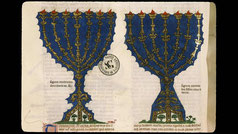
1380-1395. Postilla in Bibliam Nicolaus de Lyra (1270/75-1349), a Franciscan teacher, was among the most influential practitioners of Biblical exegesis in the Middle Ages. ©Institut de recherche et d'histoire des textes - CNRS, Shelfmark: Paris - Bibl. Sainte-Geneviève - ms. 0034. Source: Link1, Link2, Link3

1380. Rashi Menorah: Parma de-Rossi Manuscript. Source: Link

1384. The King's Bible. Miniatures of Temple implements, in colours and gold. Origin: Spain, N. E., Catalonia (Solsona), Spain. Jacob ben Joseph of Ripoll (Scribe). Object Copyright: British Library (B.L.), Kings MS 1, Photograph Copyright: Center for Jewish Art. Source: Link1, Link2, Link3, Link4, Link5, Link6

1396. Miroir Historial (Speculum historiale; Historial Mirror). Writer of the text: Vincentius Bellovacensis (Vincent de Beauvais; 1190?-1264). French translation by Jean de Vignay (1282?-13..). The copyist of this volume is Raoulet d'Orléans. Bibliothèque nationale de France, Département des Manuscrits, Français 312. Gallica. Source: Link

1396. The Palatina Library, Parma, Italy Cod. Parm. 3012. Author: Meir ben Baruch of Rothenburg (1215-1293). Perugia (Italy). © Biblioteca Palatina in Parma. This photo is only a screenshot from the website of the National Library of Israel. Please see the original website in better quality. Source: Link1, Link2

1397. Hebrew Bible. Title: Biblia Ebraea cum Comment. R. Selomoh Iarchi Aben Ezrae, David Kimki, et R. Levi ben Gerson, ut et Masora, scripta nitidissime a Salomone fil. R. Chasdai. Format: 310 x 455 mm. Plutei Collection, Italy. Biblioteca Medicea Laurenziana, Shelfmark: Plut.2.1. Source: Link1, Link1

1397. Menorah, Illumination of Ps 67; Siddur by Jehiel Beth El, Pisa. Once Florida, private collection. Photo: Schubert Collection, The Center for Jewish Art, Jerusalem. Source: Link

Late 14th century, France. Postillae on the Bible, part I, Genesis to Ecclesiasticus. Nicholas of Lyra (Nicolas de Lyre; Commentary to the Bible) contrasts Jewish and Christian understandings of the table of the shewbread and the Menorah. Captions under the Menorah distinguish that drawn by “Rabbi Salomon” (Rashi). Bodleian Jewish Museum, MS. Bodl. 251, folio 49v. Source: Link1, Link2, Link3

14th-15th century (end of 14th, beginning of 15th century). Speculum humanae salvationis. Language: German. "Biblische Erzählungen und bildliche Vorstellungen" (Biblical narratives and pictorial ideas). this seven-armed lamp hangs down from the ceiling. In the 15th century, similar images were created. But the Biblical Menorah is standing and many scholars suppose that it originally stood on a tripod. Provincial Library Amberg, Signature: SAM-Hss 2 Ms. 46. Source: Link

14th-15th century (?). Medieval Jewish Style Silver Gold-Inlaid Menorah Ring. An undated archaistic ring in 14th-15th century AD style, with carinated hoop of octagonal profile with square bezel inlaid with a gold menorah motif. Size: 6.86 grams, 25 mm overall, 19.05 mm internal diameter (approximate size British R 1/2, USA 9, Europe 19.69, Japan 19) (1"). From a Swiss collection; ex Artemission antiquities. LiveAuctioneers 2013, Lot 0485. Source: Link

14th century. Bronze candlestick. Since 1943 the St.-Gertraud-church (Frankfurt an der Oder, Germany) has housed the treasures rescued from the St.-Marien-church, which was largely destroyed in 1945. These are the city's most valuable medieval works of art. Here you can find the altar of the Virgin Mary from 1489 and the impressive seven-flamed bronze candelabra from the 2nd half of the 14th century, which is carried by four eagles (on the ground). Photo: H. Brendler. Source: Link

14th century. Museo Bronce Ccandelabro, Jewish for Hanukkah. Location: Monasterio de Montserrat-Museo, Montserrat, Barcelona, Spain. Source: Link

14th-15th century (?). A fresco in the Church of the Holy Saviour in Chora (Kariye Camii) in Istanbul (Turkey), a medieval Byzantine Greek Orthodox church preserved as the Chora Museum. In the eastern province of Rome, completely different candlestick forms have emerged, namely single straight candlesticks rising from a semicircle. The photo shows the painting before and after the cleaning. Paul Underwood: “Second Preliminary Report on the Restoration of the Frescoes in the Kariye Camii at Istanbul by the Byzantine Institute 1955.” Dumbarton Oaks Papers, vol. 11, 1957. Link1, Link2

14th century. Two ogival bronze lamps with double plates. The most striking element is that in the beaten metal a seven-armed candelabrum, menorah, and around the arms an ornament in the form of dotted. The delicacy of the work seems to indicate that it was part of a chest of a Jew. Foto: Rebeca García Merino. Museo Sefardi in Toledo, Spain. Source: Link1, Link2, Link3
Menorah Pictures from other Centuries:
Until the 1st, 2nd, 3rd, 4th, 5th, 6th-10th, 11th-13th, 15th, 16th, 17th, 18th, 19th, 20th, 21st Century
Note: It's nice to see the menorah pictures. However, according to the Bible Jesus (Hebrew Yeshua) is the true spiritual meaning behind the physical Menorah. He is the true and eternal spiritual
light: "I am the light of the world. Whoever follows me will never walk in darkness, but will have the light of life" (John 8:12). The menorah also symbolizes the Tree of Life, because
Jesus is the way to life: "I am the way, and the truth, and the life. No one comes to the Father except through me" (John 14:6). Jesus' Word and the Bible are the light in this world. "Your word is a lamp to my feet and a light to my path" (Ps
119:105 and John 1:1-17).
Copyright info and disclaimer: All content and all photos from ancient and new menorahs provided on this website is for informational purposes only. It is not allowed to publish photos from this website on other websites or printed literature. Please always use only the original sources of the photos. We make no representations as to the accuracy or completeness of any information on this website or found by following any link on this website. We will not be liable for any errors or omissions in this information. We will not be liable for any losses, injuries, or damages from the display or use of this information. We can not guarantee the validity and accuracy of the information, please always check the original source. The opinions expressed from other website owners and those providing comments are theirs alone, and do not reflect the opinions of us.



